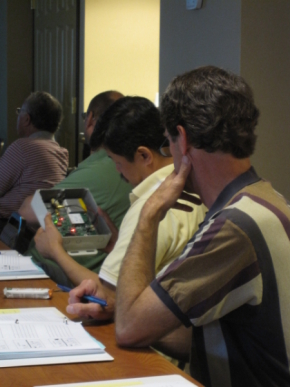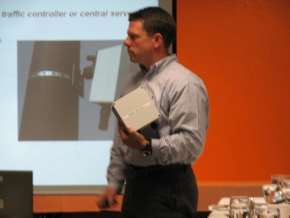Western States Rural Transportation Technology Implementers Forum (WSRTTIF)
OVERVIEW | HISTORY | CONTACTS | UPDATE | ARCHIVED UPDATES | WSRTTIF WEBSITE | FACT SHEET | IMPLEMENTATION | IMPACT
|
What does it take to make Rural ITS work? It takes technical excellence across a variety of skill areas. It takes creativity. It also helps to learn from the experiences of others. The challenges in making Rural ITS work are significant. Therefore, it’s important for ITS technology practitioners to be able to meet in order to share what they’ve learned and help advance the state-of-the-practice. Starting in 2006, the Western States Rural Transportation Technology Implementers Forum has provided ITS implementers and engineers from the western states region with valuable opportunities for detailed dialogue about some innovative engineering and communications projects designed to support the rural transportation system. The Forum is valuable, not only for the detailed and knowledgeable presentations and demonstrations, but also for the times outside of sessions where participants can network with their peers from other districts and states. The Western States Forum is unique. Speakers are given an extended amount of time to really delve into the nuts and bolts of how a project works, whether it relates to equations, source code, component-level discussion, or lessons learned. Questions and discussion are encouraged throughout and not just at the end of a presentation or demonstration. High quality technical content, discussion, transparency and trust are the main goals of the Forum. |


|
Recent Updates:
Check back soon for more Western States Forum updates.
UPDATE: Thursday, December 4th, 2025
Mark your calendar for the next Forum – June 16-18, 2026!
Save the Date!

The 21st Annual Western States Rural Transportation Technology Implementers Forum will be
June 16-18, 2026, in Yreka, California!
To make Rural ITS work, it takes technical excellence and creativity, and it helps to learn from the experiences of others.
The Forum is a venue for frank, detailed discussions and demonstrations about Rural ITS projects, right down to the nuts and bolts of how things work or don’t work. Forum attendees are those involved with ITS technology at a field level in ITS design and engineering, communications system development, systems integration, or field maintenance.
Mark your calendar now to join us at the next Forum – June 16-18, 2026 – to share your experiences and learn from others.
The Call for Abstracts will be released soon. Please check back!
Project Contacts:
Steering Committee Member:
Leann A.F. Koon
Research Associate
Western Transportation Institute
Montana State University - Bozeman
PO Box 174250
Bozeman, MT 59717-4250
(406) 994-7643
(406) 994-1697 (fax)
leann.koon "at" montana.edu
www.westerntransportationinstitute.org
Steering Committee Member:
Jeremiah Pearce, P.E.
Chief, Office of ITS Engineering and Support
Caltrans District 2
1657 Riverside Drive, MS-14
Redding, CA 96001
(530) 225-3320
(530) 225-3255 (fax)
jeremiah.pearce "at" dot.ca.gov
https://dot.ca.gov/caltrans-near-me/district-2
Steering Committee Member:
Douglas Galarus
Assistant Professor
Department of Computer Science
Montana Tech
Museum 202
1300 West Park Street
Butte, MT 59701
(406) 496-4858
dgalarus "at" mtech.edu
https://cs.mtech.edu/
Steering Committee Member:
Andres Chavez, P.E.
Chief, ITS Special Projects Branch
Caltrans, Division of Research, Innovation,
and System Information
PO Box 942873
Sacramento, CA 94273-0001
(530) 780-6877
andres.chavez "at" dot.ca.gov
https://dot.ca.gov/programs/research-innovation-system-information
OVERVIEW | HISTORY | CONTACTS | UPDATE | ARCHIVED UPDATES | WSRTTIF WEBSITE | FACT SHEET | IMPLEMENTATION | IMPACT







